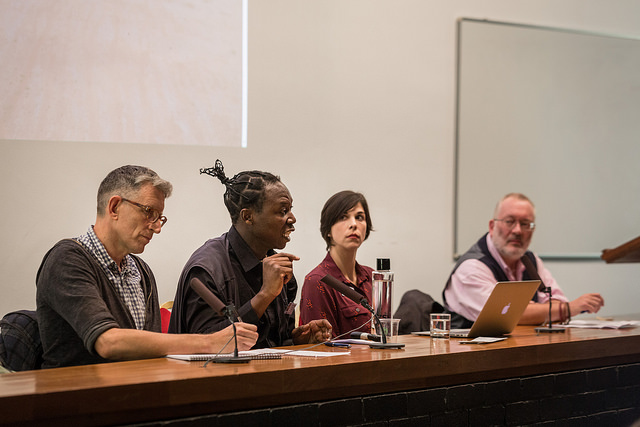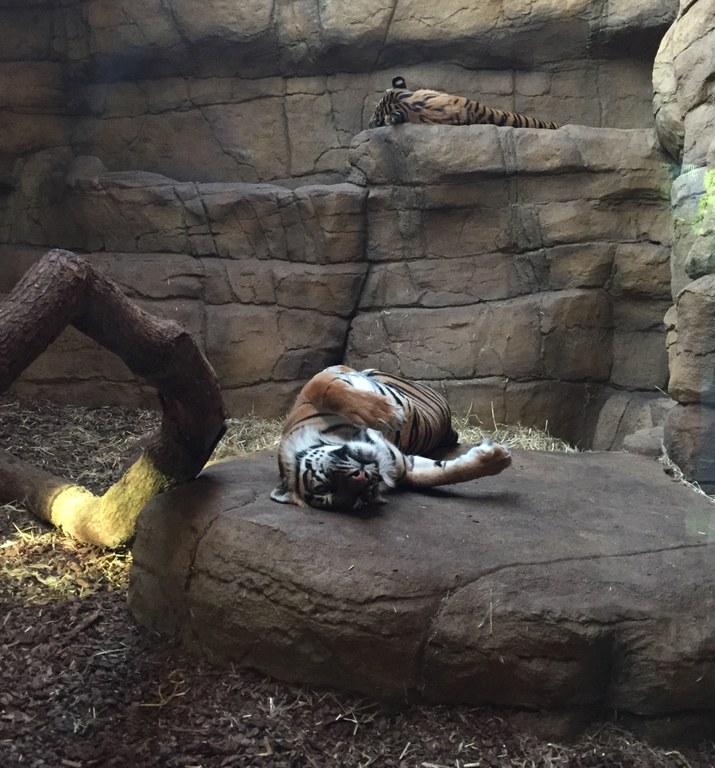
10 Oct Bridging the gap between science and policy
Researchers explore ways to bring attention to and inform policy on illegal wildlife trade. By Sara Schonhardt and James Fahn

Tigers at the London Zoo, where the city’s Zoological Society hosted the conference on illegal wildlife trade. Photo: Sara Schonhardt
More than 250 scientists, researchers, environmental experts, practitioners and reporters gathered in London in October 2018 ahead of a UK-sponsored conference on the illegal wildlife trade to talk about the threat trafficking poses to biodiversity.
Their aim was to discuss ways that science and evidence-based studies can and should inform policies aimed at curbing the illegal trafficking of species, a trade worth an estimated $23-billion annually, according to Dominic Jermey, head of the Zoological Society of London, which hosted the conference.
Although global leaders are increasingly speaking out about the need for more action to keep climate change in check, concerns about loss of biodiversity seem to go under the radar. Too often that’s because the gap between science and policy is difficult to bridge, with scientists releasing reports and research and then leaving it to policymakers to act, participants said.
“We should also keep in mind that science is usually only one dimension of the problems that are being dealt with and there can be social dimensions and political dimensions and economic dimensions as well,” said Ian Boyd, chief scientific advisor at the UK’s Department of Environment, Food and Rural Affairs.
Evidence of action and progress is important in deciding where policy should be targeted, Boyd added. In 2016, for example, only 6% of global funding put toward the illegal wildlife trade went toward reducing its drivers, he noted, suggesting the need for evidence that supports demand reduction.
A briefing note released prior to the conference said funding was needed to improve research in developing countries, increase cross-sector collaboration and bring in more community voices to build support for tackling the trade. It also emphasised a need to understand supply chains better and called for more attention to species such as fish, timber and ornamental plants that are often trafficked in greater volumes and with the potential for greater ecological impacts than bigger, more charismatic animals that are at the centre of fund-raising and awareness campaigns.
“Despite the sense of urgency, acting without a robust understanding of the issues, and an appreciation of the uncertainties, can lead to inadequate, unethical, or counterproductive outcomes for both wildlife and people,” the briefing said.

Oxpeckers associate Estacio Valoi (second left) joined a media panel discussion about community conservation concerns. Photo: Jonathan Perugia / Gaia Visual
Conservation failures
Andrea Crosta of the Elephant Action League cited efforts to protect the endangered vaquita, a cetacean species that resides in the Gulf of California, as a cautionary tale. Stating that around $110-million had been spent in trying to protect it – particularly from the ravages of destructive nets used by Mexican fishermen harvesting the swim bladders of the totoaba fish to supply traffickers in Asia – he called it “one of the biggest conservation failures of all time.”
It’s now estimated that there are only a dozen or so vaquita left in the world, because “this is a criminal problem” rather than a scientific one, Crosta said.
Rosaleen Duffy, the principal investigator with the ERC BIOSEC project at the University of Sheffield, cautioned policymakers against taking up policy based on a good story rather than evidence, highlighting the role good reporting plays in addressing illegal wildlife trade.
“I think the media can be really important and influential, and that can be for good and for ill,” Duffy said. For example, journalists can put the spotlight on species that aren’t commonly talked about, such as seahorses, or bring up stories that focus on communities with unique conservation tactics.
“Where it’s not so helpful,” she said, “is by following the story that sounds good and is often too good to be true.”
Duffy also said it was important to have a diverse range of voices informing the debate in order to generate new and innovative thinking. Too often invitations to conferences draw on already established networks, she said. “And what that means is we can just end up reproducing exactly the same conversation over and over and over again.”
She called for a “decolonisation of research” and said individual experiences and stories should be integrated into studies, since evidence of the need for action comes from more than just data points and graphs.
The conference included a series of workshops on issues such as standardising terminology for geographic information systems and panels addressing militarisation and conservation, and ways to tackle cyber-enabled wildlife crimes. It featured useful tools that researchers, journalists and activists can use, such as Legal Atlas, an online compendium of laws related to wildlife trafficking from many countries around the world. And it closed with a discussion on how the media can close the divide between policy and research.
“What we need is not just more conservation,” said Jacob Phelps, an environmental scientist and lecturer at Lancaster University’s environment centre and one of the conference organisers. “What we also need is more reflective work about how we collaborate with one another and what we think will and won’t work, which at some point requires us to acknowledge that things we thought worked, things we did like, perhaps aren’t the right things to be doing.”
“Few of us are naive enough to think that good science or good journalism is going to make good policy or good practice,” he continued. “How we strive not only to make our research more robust, which is the typical focus of a conservation conference, but also more meaningful and more relevant, that’s what we’ve hopefully started to make some dent in.”
This article appeared on the Earth Journalism Network here
